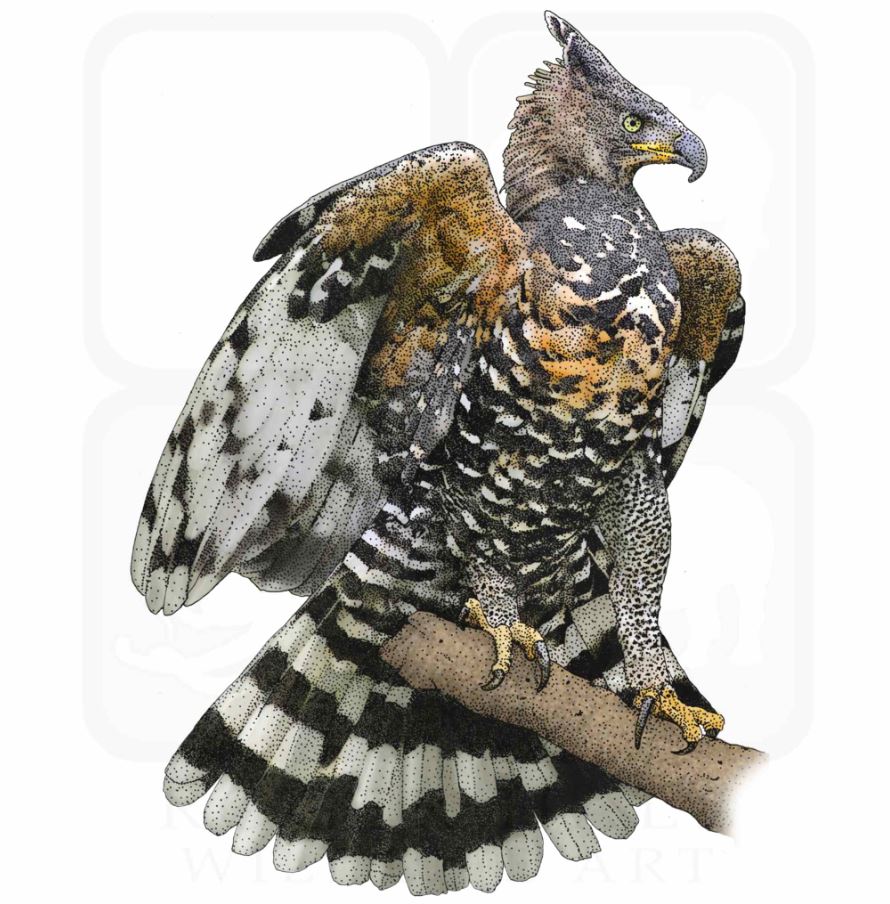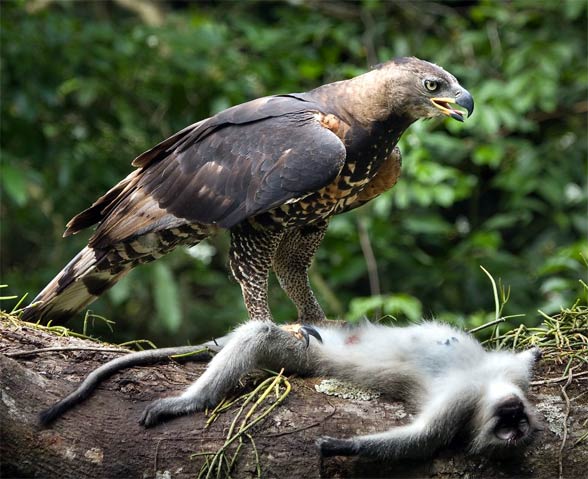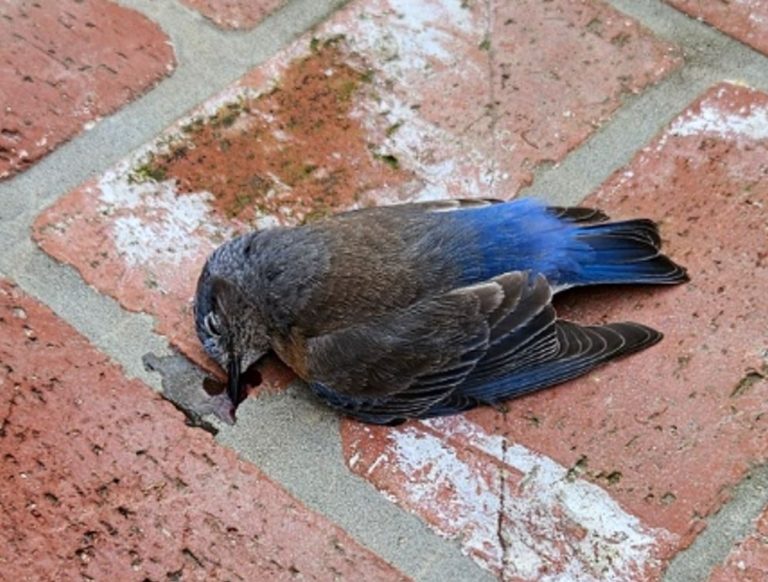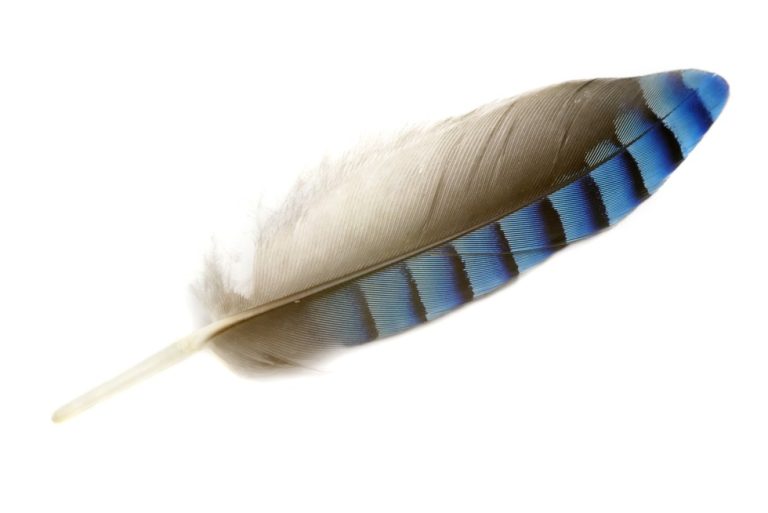Crowned Eagle: Africa’s Apex Predator That Can Hunt Monkeys Mid-Air
Introduction: Meet the Crowned Eagle
The Crowned Eagle (Stephanoaetus coronatus) is one of Africa’s most formidable birds of prey. Known for its astonishing strength and agility, this raptor has the unique ability to snatch monkeys from mid-air using talons so powerful they can crush bone.
According to the Peregrine Fund, the Crowned Eagle is considered “Africa’s most powerful eagle” when factoring in the size and weight of the prey it regularly captures. Despite its impressive abilities, this apex predator is increasingly threatened by habitat destruction and human conflict.
This article explores everything you need to know about the Crowned Eagle—from its biology and behavior to its ecological role and conservation status.
What Is a Crowned Eagle?
The Crowned Eagle belongs to the Accipitridae family and is the only living member of its genus (Stephanoaetus). Its closest relative is the extinct Malagasy Crowned Eagle, once found in Madagascar.
Key Features:
- Scientific Name: Stephanoaetus coronatus
- Wingspan: 5.9 to 6.5 feet (1.8–2 m)
- Weight: Females: 10–11 lbs (4.5–5 kg); Males: 6–10 lbs (2.7–4.5 kg)
- Habitat: Forests and woodlands of sub-Saharan Africa
- Range: From West Africa through Central and East Africa to parts of South Africa
The name “Crowned” comes from its distinct feathered crest, which can be raised to display threat or alertness.
Physical Description: Formidable and Regal
Crowned Eagles have a stocky build, broad wings, and long tails. Their plumage consists of dark brown upperparts, white underparts with black barring, and yellow eyes that pierce through the forest gloom.
“The Crowned Eagle has the most powerful grip of any eagle relative to its body size,” notes the Peregrine Fund, capable of killing prey nearly triple its weight.
Its rear talons can exceed 5 cm (2 inches), making it one of the most lethal hunters in the raptor world.
Habitat: Forest Dwellers of Africa
The Crowned Eagle prefers mature, dense forests and avoids open savannahs or arid zones. You’ll find it in:
- Rainforests of West and Central Africa
- Montane forests in Kenya, Uganda, and Tanzania
- Coastal and riverine forests of South Africa and Mozambique
These forests provide both nesting sites and an abundance of arboreal prey, especially monkeys and small antelope.
Hunting Behavior: Bone-Crushing Precision
According to the Global Raptor Information Network, the Crowned Eagle regularly hunts mammals weighing 4 to 10 kg, including monkeys, duikers, and hyraxes. This is exceptional for a bird that weighs less than 5 kg itself.
Primary Prey:
- Monkeys (colobus, vervet, blue monkeys)
- Small antelope (blue duikers, bushbuck fawns)
- Hyraxes, rodents, monitor lizards, and large birds
Hunting Strategy:
- Ambush: The eagle waits silently in the canopy before launching a surprise attack.
- Speed: Diving at over 100 mph (160 km/h), it can snatch prey mid-leap or mid-air.
- Force: Its talons can pierce the skull or spine instantly, often killing prey before it hits the ground.
“It is possibly the most powerful African raptor when considering the size of prey it takes,” states the Global Raptor Information Network.
Mid-Air Monkey Hunts: Nature’s Aerial Assassin
One of the most impressive abilities of the Crowned Eagle is its skill in capturing monkeys mid-leap or mid-air. Here’s how it works:
- Silent Observation: The eagle waits quietly in the canopy, blending in with dappled light.
- Calculated Dive: Once the monkey moves into a vulnerable position—perhaps jumping between trees—the eagle dives.
- Precision Grab: With pinpoint timing, the eagle grabs the monkey in mid-air, clamping down with talons strong enough to pierce bone.
- Lethal Blow: Often, the prey is killed instantly due to spinal or skull injuries.
This style of hunting is not only rare—it showcases the Crowned Eagle’s raw power and refined technique, honed through millions of years of evolution.
Ecosystem Role: A Keystone Predator
The Crowned Eagle is an apex predator that plays a vital ecological role in maintaining forest balance.
According to BirdLife International, their predation helps:
- Control monkey populations
- Prevent overgrazing of forest understory
- Maintain genetic fitness in prey species by removing weak or sick individuals
In ecosystems where the eagle disappears, researchers have recorded a sharp increase in monkey density, leading to deforestation due to over-browsing.
Reproduction and Nesting Behavior
Crowned Eagles form monogamous pairs and often stay together for life. Their nesting behavior is meticulous and often reflects their regal nature.
Breeding Season:
- Varies by region, but often during the dry season
Nesting Habits:
- Nests are built high in the canopy—often 50–100 feet above ground
- Made from sticks and lined with green leaves
- Some nests are reused and expanded yearly, eventually reaching 6 feet wide
Parenting:
- Female lays 1–2 eggs (usually only one chick survives)
- Incubation: ~49 days
- Fledging: ~90–115 days
- Juveniles stay with parents for up to 12 months
Due to their slow breeding rate and high parental investment, Crowned Eagles are extremely vulnerable to habitat loss.
onservation Status: Near Threatened
As of 2024, the IUCN Red List classifies the Crowned Eagle as Near Threatened, with a declining population trend.
Threats:
- Deforestation: Logging and agriculture destroy nesting sites.
- Persecution: Farmers may kill them out of fear or retaliation.
- Bushmeat trade: Indirectly affects their prey base.
- Cultural beliefs: In some regions, they are hunted for use in traditional medicine.
“This species is suspected to be declining moderately rapidly due to extensive habitat loss and persecution,” says the IUCN Red List.
Ongoing Conservation Efforts
Several international and African-based organizations are working to protect the Crowned Eagle:
- BirdLife International – monitors populations and supports local conservation
- The Peregrine Fund – conducts research on raptor ecology and threats
- National Parks & Reserves – such as Kruger NP (South Africa), Kibale NP (Uganda)
- Environmental Education – programs to reduce local persecution
Crowned Eagle vs Other Eagles
| Feature | Crowned Eagle | Martial Eagle | Harpy Eagle |
|---|---|---|---|
| Habitat | Forests | Savannahs | Tropical rainforests |
| Prey Size | Up to 30+ lbs (14 kg) | Up to 20 lbs (9 kg) | Up to 20–25 lbs (11–12 kg) |
| Talon Power | Exceptionally strong | Very strong | One of the strongest in birds |
| Nest Location | Canopy of forests | Trees or cliffs | Tall emergent rainforest trees |
| Geographic Range | Sub-Saharan Africa | Sub-Saharan Africa | Central and South America |
Fascinating Facts About the Crowned Eagle
- Skull Crusher: Can deliver over 500 psi of force with its talons.
- Silent Hunter: Uses trees as cover and doesn’t soar like other eagles.
- Massive Nests: Can exceed 6 feet in diameter after years of reuse.
- Distinctive Calls: High-pitched scream—recordings available at Macaulay Library – Cornell Lab.
Final Thoughts: Why the Crowned Eagle Deserves Our Protection
The Crowned Eagle is not just a bird—it’s a symbol of power, grace, and the primal forces of nature. As one of the most formidable predators on the African continent, it plays an irreplaceable role in maintaining ecological balance.
Yet, its future hangs in the balance.
Protecting this majestic species means preserving Africa’s forests, educating local communities, and celebrating one of the greatest aerial hunters nature has ever produced.
FAQs About the Crowned Eagle
What do Crowned Eagles eat?
Their diet mainly includes monkeys, small antelope, hyraxes, and large rodents.
Where can I see a Crowned Eagle in the wild?
You can spot them in forested regions of South Africa, Uganda, Kenya, Ghana, and the Congo Basin—especially in national parks.
How powerful is a Crowned Eagle’s grip?
Their talons exert a grip force of 400–500 psi, capable of crushing bones instantly.
Is the Crowned Eagle endangered?
Not yet, but it is listed as Near Threatened due to habitat destruction and human conflict.
If you enjoyed this guide, be sure to check out our in-depth article on Baby Pelican Facts: What They Look Like, Eat, and How They Grow So Big!









